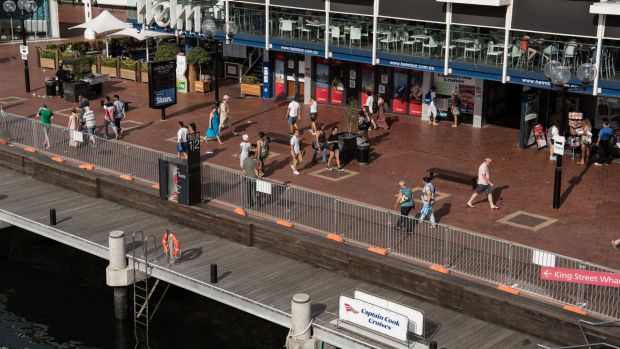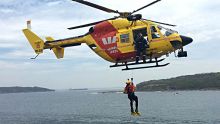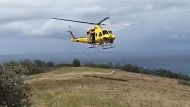Fence the harbour? Are they mad? The story on the proposal to ring-fence Darling Harbour sat beside one on the NSW road toll. The scale is different. In five years we've had two drowning deaths at Darling Harbour; 1741 on the roads. But both issues go directly to the fatty heart of nanny-statism.
The questions are these. To what extent is public administration responsible for personal safety? How much public liberty will we sacrifice to achieve it? And how dull must our edge become before we call time?
More NSW News Videos
NYE revellers flock to Sydney Harbour
Crowds gather along the foreshore in anticipation of Sydney Harbour's famous New Year's Eve firework display. Vision courtesy ABC News 24.
Let me fess up right away. To me, the public realm is as much about dignifying life as cosseting it. I'd like a shared life that treated us like grown-ups.
A few years ago Hugh Buhrich, German-born architect of two celebrated dwellings in Castlecrag, was showing me the house where he and his architect-wife Eva had raised their twin boys.
Buhrich was a tough old bird. Already in his 90s, he danced blithely up a cantilevered circular stair to a roof-terrace that overlooked a steep, bushy scarp. Neither stair nor terrace possessed so much as a whisper of rail or balustrade. Quite apart from any illegality, this was also, I suggested, brave, especially with small children. "Evolution," barked Buhrich. "Natural selection."
The anecdote illustrates just how far our attitudes have shifted. Buhrich, a pre-war refugee, had known real danger – so felt only disdain for the miniature fears of suburban Sydney. We might find his attitude a tad flinty but Buhrich's point was not just a moral one. His houses owe their genius to precisely this radicalism.
Our lives are already the safest in history: so safe that we delude ourselves into thinking perfect safety is possible. In fact, it's not even desirable and should, I respectfully suggest, be tempered by recognition that danger and transgression are how we define ourselves. Edge, in threatening death, keeps us fully alive.
Already, our safety craving has destroyed the city's nightlife. The deaths that triggered it are of course significant, but the lockout's destructive impact on clubs and venues, live music and late night youth-culture has been catastrophic. Do we really want to destroy the city's relationship with its harbour as well? Do we conceive Sydney as one big retirement village?

Regarding Darling Harbour, the families of the two drowned men naturally adopt a whatever-it-takes approach. No doubt I'd feel the same, in their shoes. But this cannot be the only consideration.
Even regarding roads – which kill almost 900 times as many – I have my doubts. Yes, it's terrible that people die. Yes, there are innocent victims. But already we've turned roads that were engaging and exciting into dull mechanical conduits.

The new improved version of Forty Bends Road, within the Blue Mountains Highway, has three or four dull little curves that barely warrant the name "bend". Villages like Lawson, once picturesque billabongs off this meandering stream, are now blown apart, asphalted to the hilt and corseted in flavourless conformism. The road itself could be anywhere or nowhere. Dull as.
I know what you'll say. If it saves even one life, it's worth it. But has it? And is it?

The recent history of NSW road deaths suggests there may be more to road safety than simply improving roads or reducing speed limits. Over the past five years our roads have become both safer and slower but the toll, having dropped for two years (from 369 in 2012 to 333, then 307), rose in 2015 to 348 and again last year to 384. So how does the causality work, exactly? We don't know.
Many of our roads, designed now for far higher speeds, have speed limits whose wild inconstancy – fluctuating every few kilometres from 110 to 90 then 60, and back to 80km/h – suggest our minders are less interested in safety than simple revenue.
My point? Cause and effect are not simple. And while safety improvements show diminishing returns the cost – in money, liberty or aesthetics – keeps going up. So with something like fencing off the harbour you want to be sure; sure that it is in fact safer, and that it's worth it.
With this in mind, let us consider the Darling Harbour proposal. We can expect something resembling a giant backyard pool-fence; a palisade of ugly rail-topped verticals without even the charm of those 19th century spearheads – on which inebriates, with some effort, could self-impale. So. Questions. Would it work? Is the ugliness worth it? And is it really government's role to delete all danger from our public lives?
First, efficacy. Most such accidental deaths – the Darling Harbour drownings, the one-punchers, and three-quarters of the road toll – are young men. (Never mind the 71 women killed domestically last year; more than one a week). Jason Daep was pushed in during a fight; Brendan Hickey fell in drunkenly during Vivid 2014. Even if such a fence might have prevented these particular deaths, isn't it likely that to young men after a night out a fence will simply seem something to climb? Play equipment?
Second, aesthetics. Darling Harbour has always been aesthetically challenged. On the new ICC buildings, which are even bigger, clunkier and cheaper-looking than the old, their turf roof and grassy terraces, designed to be public, already fenced off. All very Brisbane-on-a-bad-day.
The brand new public realm, meanwhile, is the old one with all charm suctioned out. Its plain timber boardwalk and white-painted wooden piles – where at least you can dangle your feet in water if you wish – are the precinct's last shred of authenticity. Kill that, with an almighty pool fence, and Darling Harbour will be little more than a public playpen around a couple of sad, safe little fountains.
Third, danger and dignity. A dignifying public realm that treats us like adults, not infants, must let us find our own edge. This will always involve the risk of going over. Don't fence us in.
Twitter: @emfarrelly

















165 comments
New User? Sign up